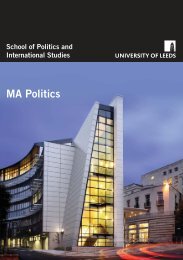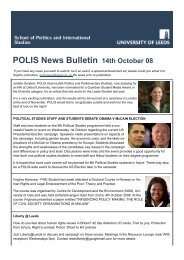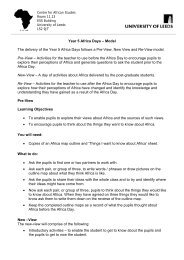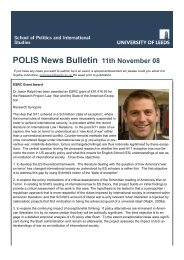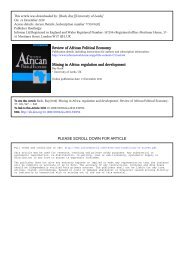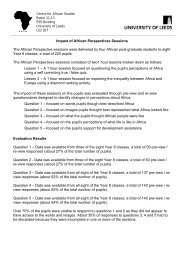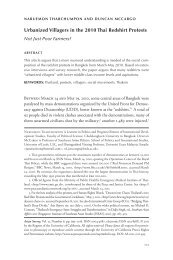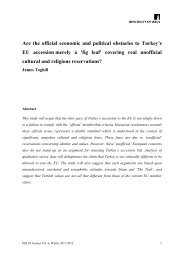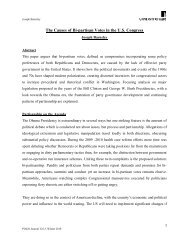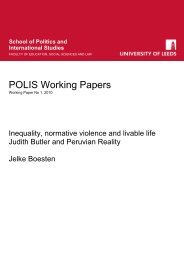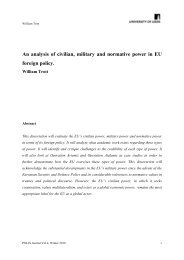Buddhism, Democracy and Identity in Thailand - Taylor & Francis ...
Buddhism, Democracy and Identity in Thailand - Taylor & Francis ...
Buddhism, Democracy and Identity in Thailand - Taylor & Francis ...
- No tags were found...
You also want an ePaper? Increase the reach of your titles
YUMPU automatically turns print PDFs into web optimized ePapers that Google loves.
168 DEMOCRATIZATIONScholars such as Keyes <strong>and</strong> Swearer have argued optimistically that Thai<strong>Buddhism</strong> now constitutes a ‘broad church’, reflect<strong>in</strong>g the pluralism of widerThai society. In support of this argument, they cite the emergence of movementssuch as Santi Asoke <strong>and</strong> Wat Thammakai, the political successesenjoyed by Chamlong Srimuang, <strong>and</strong> dissident voices such as SulakSivaraksa. Unfortunately, these arguments are simply not credible, s<strong>in</strong>cethey adopt far too benign a view of the role of the Thai state. There isample evidence that the Thai state is will<strong>in</strong>g to use all means at its disposalto defend a highly conservative, orthodox <strong>and</strong> authoritarian mode of<strong>Buddhism</strong> that is totally at variance with the diversity <strong>and</strong> vitality of thewider society, <strong>and</strong> entirely at odds with the open political order conv<strong>in</strong>c<strong>in</strong>glyushered <strong>in</strong> dur<strong>in</strong>g the 1990s. Chastened by the blood on its h<strong>and</strong>s over the May1992 demonstrations, the world’s most coup-happy military now rema<strong>in</strong>slargely conf<strong>in</strong>ed to the barracks. Underm<strong>in</strong>ed by the 1997 economic crisisthat reduced public confidence <strong>in</strong> their management, <strong>and</strong> <strong>in</strong>timidated by thepowerful political forces of Thaks<strong>in</strong> <strong>and</strong> his party, the once-powerful bureaucracyis on the defensive. Yet the sangha, protected by the umbilical cord whichl<strong>in</strong>ks it to the untouchable monarchy, rema<strong>in</strong>s substantially unchallenged.Thail<strong>and</strong>’s Buddhist order has not yet been made to face the consequencesof its <strong>in</strong>competence, <strong>in</strong>tolerance <strong>and</strong> venality. Thail<strong>and</strong> has been experienc<strong>in</strong>ggradual political liberalization s<strong>in</strong>ce the 1970s, not because of the prevail<strong>in</strong>greligious climate, but <strong>in</strong> spite of the deep conservatism of its Buddhist order.NOTES1. Ian Harris, ‘<strong>Buddhism</strong> <strong>and</strong> Politics <strong>in</strong> Asia: The Textual <strong>and</strong> Historical Roots’, <strong>in</strong> Ian Harris(ed.), <strong>Buddhism</strong> <strong>and</strong> Politics <strong>in</strong> Twentieth Century Asia (London: Cont<strong>in</strong>uum, 1999), p.19.2. Larry Diamond, ‘Political Culture <strong>and</strong> <strong>Democracy</strong>’, <strong>in</strong> Larry Diamond (ed.), Political Culture<strong>and</strong> <strong>Democracy</strong> <strong>in</strong> Develop<strong>in</strong>g Countries (Boulder, CO: Lynne Rienner, 1993), p.24.3. Charles F. Keyes, ‘Buddhist Politics <strong>and</strong> Their Revolutionary Orig<strong>in</strong>s <strong>in</strong> Thail<strong>and</strong>’, InternationalPolitical Science Review, Vol.10, No.2 (1989), pp.121–42.4. Best known as the ruler depicted <strong>in</strong> ‘The K<strong>in</strong>g <strong>and</strong> I’, Rama IV, or K<strong>in</strong>g Mongkut, spent alengthy period <strong>in</strong> the monkhood before ascend<strong>in</strong>g to the throne, <strong>and</strong> established a new, stricterBuddhist sect.5. Keyes (note 3) p.137.6. Interview with Suwanna Satha-an<strong>and</strong>, Chulalongkorn University, 22 November 1995.7. Peter Jackson, <strong>Buddhism</strong>, Legitimation <strong>and</strong> Conflict: The Political Functions of Urban Thai<strong>Buddhism</strong> (S<strong>in</strong>gapore: ISEAS, 1989), p.224.8. Somboon Suksamran, <strong>Buddhism</strong> <strong>and</strong> Political Legitimacy, Chulalongkorn UniversityResearch Report Series No.2 (Bangkok: Chulalongkorn University, 1993), p.63.9. Benedict R. O’G. Anderson, ‘Studies of the Thai State: The State of Thai Studies’, <strong>in</strong> EliezerB. Ayal (ed.), The Study of Thail<strong>and</strong> (Athens, OH: Ohio Center for International Studies,Southeast Asia Program, 1978), p.199.10. For the best overview of Thai politics from the 1930s to the 1970s, see John L.S. Girl<strong>in</strong>g,Thail<strong>and</strong>: Society <strong>and</strong> Politics (Ithaca, NY: Cornell University Press, 1981).11. For the most detailed exam<strong>in</strong>ation, see J.L. <strong>Taylor</strong>, Forest Monks <strong>and</strong> the Nation-State(S<strong>in</strong>gapore: ISEAS 1993).



